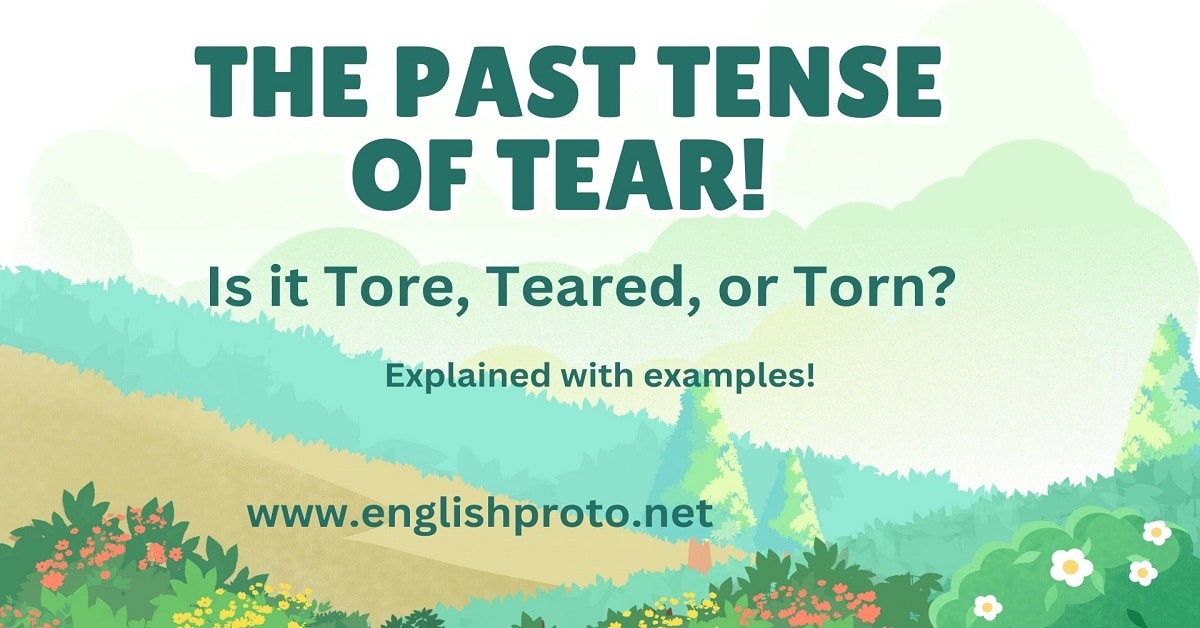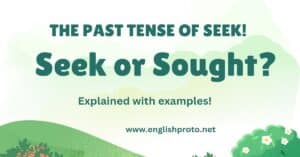The Past Tense of Tear? Is it Tore, Teared, or Torn? This common question often leaves even native English speakers scratching their heads.
If you’ve ever wondered which form of tear to use when talking about past actions, you’re not alone! Whether you’re writing an essay, crafting a text, or just trying to speak correctly, getting the past tense of tear right can make all the difference.
In this article, we’ll clear up the confusion once and for all. Say goodbye to doubts about whether it’s tore, teared, or torn and learn exactly how to use each form with confidence!
Quick Summary
To quickly answer the burning question: The past tense of tear is tore, and the past participle is torn. Here’s the breakdown:
- Base Form: tear (I tear the paper.)
- Past Tense: tore (I tore the paper yesterday.)
- Past Participle: torn (The paper has been torn.)
Key Takeaways:
- Tore is used in the simple past tense when describing actions that occurred in the past.
- Torn is the past participle used with auxiliary verbs like have, has, or had to describe an action that has been completed but still holds relevance.
- Teared is incorrect and should be avoided in both the past tense and the past participle.
Reasons for Confusion
If you’re wondering why so many people confuse tear, tore, and torn, you’re not alone. Understanding the reasons behind the confusion can help clarify how to use these forms correctly.
1. The Regular Verb Trap
One of the main reasons people get confused is the prevalence of regular verbs in the English language. Regular verbs follow the predictable “-ed” rule to form their past tense and past participles. For example:
- Walk → Walked
- Talk → Talked
This regular pattern makes it tempting to think that tear should follow the same rule. After all, tear and teared sound similar, right? However, tear is an irregular verb, which means it doesn’t follow this pattern. The past tense of tear is tore, and the past participle is torn—no “-ed” ending here.
2. Sound Confusion
Another reason for confusion lies in pronunciation. Tear (as in to rip something) sounds exactly the same as tear (the tear that comes from your eyes). This makes it easy to mix up the two meanings when writing or speaking.
For instance:
- Tear (to rip): I will tear this paper.
- Tear (a drop of water from the eye): A tear rolled down her cheek.
Because both words are pronounced the same way, it’s crucial to pay attention to the context to decide whether you’re referring to the verb tear (to rip) or the noun tear (a droplet from the eye).
3. Regional Influences and Dialects
The way people speak varies from one region to another, and this can influence how they use verbs like tear. Some regional dialects might be more lenient about dropping the “n” in torn or using teared in place of tore.
These variations, while common in casual speech, don’t always follow the standard rules of grammar. It’s important to keep the standard forms of tore and torn in mind when writing formally.
Detailed Explanation
1. Base Form: Tear
The base form of the verb tear is used when talking about actions happening in the present. You might use this form to describe something you regularly do or something you’re doing at the moment.
Example Sentences:
- I always tear my paper before I recycle it.
- She likes to tear the labels off old cans.
- Every morning, we tear the newspaper in half to separate the sections.
Notice that in these examples, tear is in the present tense and describes an ongoing or habitual action. This is the verb you will use when talking about something you are currently doing or do regularly.
2. Past Tense: Tore
When you want to describe an action that occurred at a specific point in the past, you use tore. Tore is the simple past tense of tear, and it’s used to describe completed actions without the need for auxiliary verbs like have or had.
Examples:
- I tore the paper into small pieces yesterday.
- She tore her dress when she caught it on the nail.
- He tore the envelope open.
Notice that tore is used to describe actions that have already happened, and there is no auxiliary verb involved.
3. Past Participle: Torn
The past participle of tear is torn, and it’s used when the action is completed but has relevance to the present. You will often see torn used with auxiliary verbs like have, has, or had. It emphasizes that the action has been completed and has some effect or consequence in the present.
Example Sentences:
- I have torn the paper into pieces.
- The letter had been torn by the time I arrived.
- The fabric has been torn beyond repair.
In these examples, notice how the past participle torn is always paired with an auxiliary verb like have or had. This is an important feature to remember when using past participles.
Quick Tip: The key difference between tore and torn is that tore refers to a simple past action, while torn requires an auxiliary verb (like have) and suggests that the action has a present consequence.
Common Errors
It’s easy to make mistakes when using tear, tore, and torn, especially since there are so many irregular verbs in English that follow different patterns. Below are some common errors people make with tear:
1. Using “Teared” Instead of “Tore”
One of the most common mistakes is using teared instead of tore. Since tear is irregular, its past tense is tore, not teared. You should always use tore when referring to an action that took place in the past.
Incorrect: I teared the paper yesterday.
Correct: I tore the paper yesterday.
2. Using “Tore” as a Past Participle
Another mistake is using tore in place of torn as the past participle. Remember, tore is only used in the simple past tense, while torn is the correct form for the past participle.
Incorrect: I have tore the paper.
Correct: I have torn the paper.
3. Mixing Up “Tear” with “Tear” (the Noun)
Lastly, there’s the confusion between the verb tear (to rip) and the noun tear (a drop of water from your eye). This is especially tricky since the two words are spelled the same but pronounced differently. In writing, it’s important to rely on context to understand whether you’re talking about the verb tear or the noun tear.
Example:
- She shed a tear when she heard the news. (Here, tear is a noun.)
- She will tear the paper into small pieces. (Here, tear is a verb.)
Quick Tip: Tear (the verb) sounds like “air,” while tear (the noun) sounds like “ear.” The pronunciation difference can help clarify which meaning is being used.
Synonyms or Alternatives
While tear is a versatile verb, there are situations where you may want to use a synonym to add variety to your language or clarify meaning. Here are some alternatives you might consider:
- Rip: She ripped the letter open.
- Shred: He shredded the documents after reading them.
- Split: They split the log in half.
Each of these synonyms has a slightly different connotation. For example, shred often refers to cutting something into smaller, fine pieces, while rip and split usually imply tearing along a line.
Examples in Sentences
To help solidify your understanding of how tear, tore, and torn work, let’s look at some real-life examples of how these words function in sentences.
Present Tense (Base Form: Tear)
- Every morning, I tear the newspaper into sections.
- I usually tear out pages from my notebook when I make mistakes.
- My son loves to tear up his old homework.
Past Tense (Tore)
- I tore the invitation in half by accident.
- She tore up the letter after reading it.
- He tore the fabric as he tried to repair the old coat.
Past Participle (Torn)
- I have torn the paper into tiny pieces.
- The letter has been torn apart by the wind.
- By the time we reached the scene, the fabric had already been torn.
Origins and History
The word tear has its roots in Old English. The verb tear comes from the Old English word teran, meaning “to split or rend.” Over time, it evolved in spelling and usage but retained its irregular conjugation.
English, like many languages, has absorbed influences from other languages, including Latin, Norse, and Old French, which has contributed to the formation of many irregular verbs. Tear is just one of many that break the regular patterns.
In fact, this pattern of irregular verbs (where the past tense and past participle don’t follow the expected rules) is a fundamental feature of the evolution of the English language. It speaks to how English grammar has been shaped over centuries.
Conclusion
The past tense of tear is tore, and its past participle is torn. Understanding these forms is essential for clear, accurate communication in both writing and speech. By avoiding common mistakes like using teared or tore as a past participle, you’ll ensure that your sentences flow naturally and correctly.
Here are the key takeaways:
- Tore is used for the simple past tense.
- Torn is used for the past participle, often with auxiliary verbs like have or had.
- Avoid using teared—it’s not a valid form.
Mastering these forms will help you write more effectively and sound more polished. Whether you’re a student, professional, or simply an English enthusiast, knowing how to use tear, tore, and torn will make you a more confident communicator.



